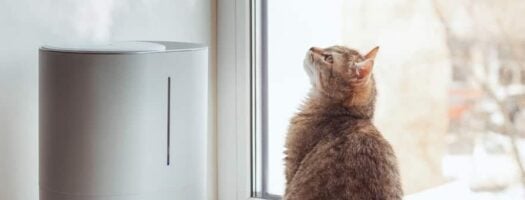The 11 Best Flea Killers for Yards in 2026
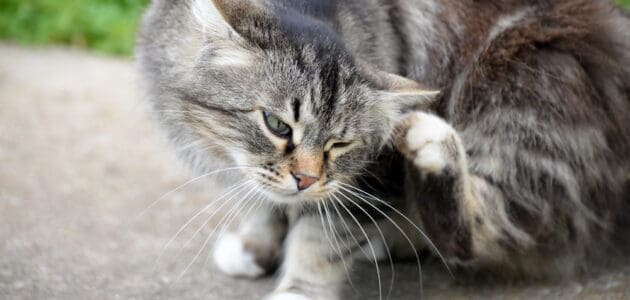
Constant scratching. Red, irritated skin. Hair loss. All are signs that your pet is dealing with flea bites. Try as you might, it’s unlikely you’ll be able to totally escape the specter of fleas if you’ve got household pets.
That’s because, in addition to living on your beloved pets, it’s estimated that there are at least 300 types of fleas in the U.S. alone, and they can find their way into your yard in a variety of ways. The good news is that there are many flea killers you can apply outdoors to keep fleas from your yard.
- Important Factors in Choosing a Flea Killer for Your Yard
- Top 11 Best Flea Killers for Yards 2026
- 1. Best Overall Yard Flea Killer: Vet’s Best Yard & Kennel Spray
- 2. Best Premium Yard Flea Killer: Wondercide Flea & Tick Spray
- 3. Best Budget Yard Flea Killer: Cutter Backyard Bug Control Spray
- 4. Best Solid Yard Flea Killer: BioAdvanced Complete Insect Killer
- 5. Best Yard Flea Killer for Broad Protection: Ortho Home Defense Insect Killer
- 6. Most Effective Yard Flea Killer: Black Flag Flea & Tick Yard Treatment
- 7. Best Flea Killer for Big Yards: Advantage Flea & Tick Yard Spray
- 8. Best Flea Killer for Small Yards: Natural Chemistry Yard & Kennel Spray
- 9. Most Eco-Friendly Yard Flea Killer: Eco Defense Flea & Tick Control
- 10. Best Yard Flea Killer for Gardeners: Adams Yard Spray
- 11. Longest-Lasting Yard Flea Killer: Control Solutions Pivot 10
- Complete Guide to Yard Flea Killers
- Yard Flea Killer FAQs
- Final Thoughts
Important Factors in Choosing a Flea Killer for Your Yard
Most flea killers designed for use in residential areas, like yards and gardens, are pretty much the same, with a few crucial areas to consider in weighing your options.
Synthetic vs. Natural
When it comes to flea killers for the yard, the single biggest choice you’ll make will be between synthetic and natural products. Synthetic products use insecticide chemicals to treat yards, while natural products use things like essential oils. Here’s a thorough breakdown of all the active ingredients you’ll find in these types of products.
Application Type
Most outdoor flea killers come in the form of a sprayer that attaches to a garden hose that causes water to mix with a concentrate that then gets sprayed all over your yard. There are some notable exceptions, for instance, (a granule-based one and a non-nozzle concentrate), but most have the same method of application.
Coverage Area
Each product has a different total area that can be effectively treated with a single application. For the products that made our list, that ranges from 4,500 square feet to 16,000 square feet, with most covering at least 5,000 square feet.
Duration of Effectiveness
Similarly, each flea killer offers a duration of protection, meaning the length of time the manufacturer indicates that your yard will be protected from fleas. This is highly variable, but it’s also important to note that this could be affected by things like how accessible your yard is to wild animals, who are often flea vectors, how large it is, or how extensive the flea problem is. In short, your mileage will vary quite a bit, so while it’s good to keep this number in mind, if a product is effective for you, it’s probably good to stick with it.
Price
This is a concern with any product you buy. However, flea killers tend to be quite cheap, with some costing only $10-$15 for a bottle. They vary, though, and natural products tend to be more expensive.
Now that you know what to look for in a yard flea killer, let’s check out the best available options this year.
Top 11 Best Flea Killers for Yards 2026
1. Best Overall Yard Flea Killer: Vet’s Best Yard & Kennel Spray
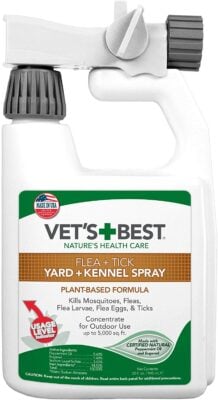
Editor’s Rating:
Why we like it: Vet’s Best is a natural flea killer designed with the health of pets in mind. Its low cost and acceptable effectiveness provide peace of mind for pet parents and pets alike.
At a Glance:
- Application Type: Hose
- Duration: 12 weeks
- Coverage Area: 5,000 square feet
- Price: $
Ease of Use
As with most other flea sprays designed for the yard, Vet’s Best is simple to attach to your garden hose, using the power of the water supply to coat and treat your yard for fleas and ticks (and mosquitoes), though it typically will not kill insects on contact. On the other hand, there is no added fragrance in this spray, so it’s unlikely to be terribly offensive to your senses.
Value & Effectiveness
Like all other products on our list that are made with natural ingredients, effectiveness isn’t the highest. But for those who are buying a flea killer for a yard in which dogs, cats, and other pets will live, harsh chemicals may not be worth enhanced effectiveness anyway. That said, among natural products, Vet’s Best spray is one of the most effective, and it’s also one of the cheapest on the list.
Good to Know
Depending on how high the concentration is in the area where you’ve applied the spray, this product can be harmful to honeybees, which are important pollinators and crucial cogs of the entire ecosystem. This may be less concerning for those without flowers or other plants in their yard, but if your yard has a lot of bee-attracting plants, it’s important to keep that in mind.
Additionally, unlike some other natural products, Vet’s Best doesn’t use cedarwood oil, which has been known to sicken some animals, especially dogs, if they manage to ingest large quantities. Still, it’s important to follow the instructions so you can be sure your pets aren’t exposed to dangerous amounts of any substances.
Pros
- Inexpensive
- Effective for a natural product
- Simple to use
- Made without cedarwood oil
Cons
- Potentially harmful to bees
- Less effective than chemical sprays
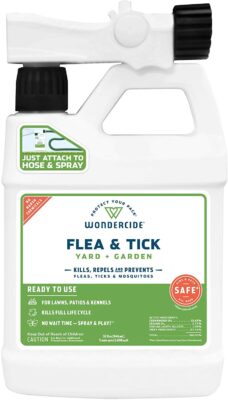
Editor’s Rating:
Why we like it: Wondercide’s gentle ingredients are ideal for preventing fleas from invading your yard in the first place. While it’s expensive, even for a natural option, its pleasant smell and preventive ingredients make it worthwhile.
At a Glance:
- Application Type: Hose
- Duration: 6 weeks
- Coverage Area: 5,000 square feet
- Price: $$
Ease of Use
The hose spray attachment is simple to use, though you probably will need to apply a couple of coats of this product. Plus, it’s got a pleasant smell and hasn’t been shown to be harmful to honeybees.
Value & Effectiveness
Wondercide is the most expensive of the sprays that use natural ingredients, and a single application is not effective against a serious infestation of fleas. So, that means not only is the product more expensive to purchase, but you’ll probably have to buy enough to do more than one coat on your yard. That said, once you’ve cured a serious major infestation, this is an excellent and largely pet-safe natural product. It can also help prevent flea or tick infestations, so it’s a good option if you’re looking to keep fleas out before a problem begins.
Good to Know
We said this product is largely pet-safe, so where could there be a potential issue? The active ingredient in Wondercide is cedarwood oil, which has been shown to be harmful to dogs who ingest large amounts. The most likely scenario for pet owners is they saturate their grass but unknowingly produce some overspray onto hard surfaces like decks or fences, and once they let their pets back into the yard, their dogs find the new fence coating quite tasty.
If you have dogs or other pets who are prone to chewing or licking things they find in the yard, you may want to consider a different product. Also, be sure to bring inside any water bowls so they don’t fall victim to overspray. If you’re concerned about these issues, consider some flea spray alternatives.
Pros
- Effective as a preventive measure
- Pleasant smell
- Unlikely to harm honeybees
- Simple application method
Cons
- Expensive for natural product
- Possibly dangerous for dogs
3. Best Budget Yard Flea Killer: Cutter Backyard Bug Control Spray
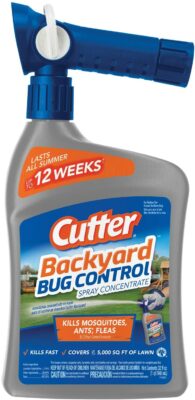
Editor’s Rating:
Why we like it: Cutter’s backyard spray is easy-to-use and among the most effective products on the list, which is not surprising considering the synthetic bug killer chemical that’s its main ingredient.
At a Glance:
- Application Type: Hose
- Duration: 12 weeks
- Coverage Area: 5,000 square feet
- Price: $
Ease of Use
Cutter’s backyard spray can kill a huge range of bugs using a simple hose applicator. The active ingredient, lambda-cyhalothrin, belongs to a class of ingredients called pyrethroids that, while commonly used to prevent insect infestations, have been known to be toxic to bees and even mammals if ingested.
Because of this, it’s vital that consumers follow all label instructions to ensure that no people or pets are put in danger, which is an unfortunate concern with all synthetic flea sprays.
Value & Effectiveness
As is the case with all the synthetic flea sprays on our list, Cutter’s backyard spray is incredibly effective, killing a huge range of bugs, including fleas and ticks. That said, though, this product is designed for mosquitoes, though it still should kill fleas on contact, and it provides up to three months of protection. It’s also the cheapest product on the list, providing incredible bang for the buck (if you can stand the strong chemical smell).
Good to Know
As we mentioned, it’s important to exercise caution with this product because the main ingredient is toxic to bees, which means that people who have plants or flowers in their yard that they want to keep alive with the help of pollinators will want to consider a different product.
Also, if you have pets that are prone to chewing or rolling in grass, it may be advisable to wait a day or two or after a big rain before letting your dog in the yard to ensure that all residue of the product has been absorbed by the ground and won’t impact your pets (or people).
Pros
- Highly effective
- Inexpensive
- Long duration
- Kills fleas and mosquitoes
Cons
- Toxic to bees and fish
- Potentially dangerous to pets if ingested
4. Best Solid Yard Flea Killer: BioAdvanced Complete Insect Killer
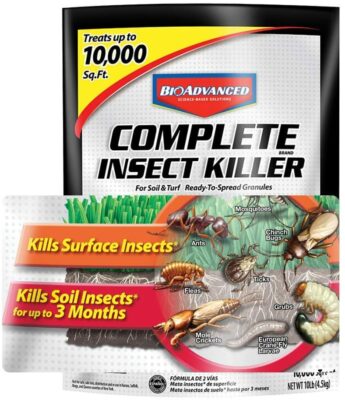
Editor’s Rating:
Why we like it: While applying it to your yard is more of a production than with other products on this list, this option will kill any and all pests in your yard.
At a Glance:
- Application Type: Granules
- Duration: 12 weeks
- Coverage Area: 10,000 square feet
- Price: $$
Ease of Use
Applying this product to your yard is much more complicated than simply attaching a hose to a bottle. While you could use your gloved hands, BioAdvanced Complete Insect Killer is best when applied using a seed spreader, which most people probably don’t already have., though they’re not all that expensive to buy. (Here’s a good one to consider.)
Once you spread the granules consistently over the surface of the yard, you must soak them with a hose or other water sprayer so that they become saturated, which activates the ingredients. Be sure to closely follow all instructions and take care not to create runoff in neighboring areas.
Value & Effectiveness
This product offers a huge coverage area, and the main ingredient, imidacloprid, is an incredibly effective pesticide that’s restricted by law in some areas. That means, depending on where you live, you may not be able to purchase this product, including in New York, Connecticut, Vermont, and Maryland.
But if it’s available where you live, and you’re able to follow all the instructions to limit the chances of the pesticide causing any collateral damage, it’s an excellent value considering how well it kills bugs.
Good to Know
One of the reasons imidacloprid-based insecticides are controversial is that some research has connected them to colony collapse disorder, which has decimated bee populations around the world. That said, this connection is far from settled fact, and products like these are effective enough that many people are comfortable with the risk.
However, it’s particularly important if you’re using products like this to take extra precautions to ensure your family and pets aren’t exposed to an unnecessary level of risk.
Pros
- Very effective
- Wide coverage area
- Inexpensive
- Kills wide range of pests
Cons
- Controversial main ingredient
- Complex application method
5. Best Yard Flea Killer for Broad Protection: Ortho Home Defense Insect Killer
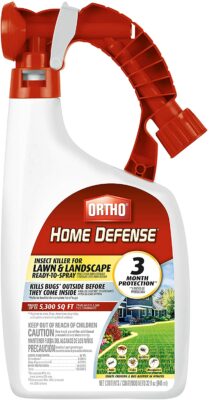
Editor’s Rating:
Why we like it: Ortho Home Defense yard insect killer is easy to use and can provide protection against nearly 250 types of insects, making it ideal for people who are itching to get rid of more than just fleas.
At a Glance:
- Application Type: Hose
- Duration: 12 weeks
- Coverage Area: 5,300 square feet
- Price: $
Ease of Use
The hose spray applicator is easy to operate, and Ortho Home Defense’s outdoor insect killer covers a large area, more than 5,000 square feet.
Value & Effectiveness
As a pyrethroid-based insecticide, Ortho Home Defense’s yard spray is highly effective, with more than 230 types of insects susceptible to the formulation. It’s also the second-cheapest product on the list, which provides excellent value for the money.
Good to Know
Both main active ingredients in this product are listed as possible human carcinogens, though that doesn’t mean they are necessarily dangerous. However, the product can be dangerous if ingested by people or plants, and it’s highly toxic to bees.
All the synthetic products on the list come with a greater inherent risk to people and animals, though, so provided you follow the instructions and keep your pets out of the yard until the spray dries fully, there is a low risk of negative side effects.
Pros
- Cheap
- Kills huge range of insects
- Large coverage area
- Simple application
Cons
- Toxic to bees
- Ingredient listed as possible human carcinogen
6. Most Effective Yard Flea Killer: Black Flag Flea & Tick Yard Treatment
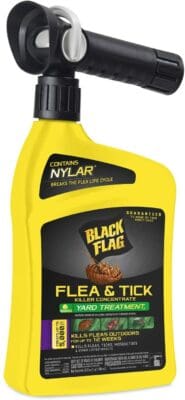
Editor’s Rating:
Why we like it: Black Flag’s flea and tick spray is one of the few synthetic treatments designed specifically for killing and preventing fleas and ticks. The nature of the ingredients mean that the reproductive cycle of these pests is disrupted, causing them eventually to die off.
At a Glance:
- Application Type: Hose
- Duration: 12 weeks
- Coverage Area: 5,000 square feet
- Price: $
Ease of Use
Black Flag’s yard spray is designed to kill fleas and ticks, and the hose spray applicator is easy to use on a 5,000-square-foot coverage area.
Value & Effectiveness
The spray is inexpensive, and because it’s formulated for fleas and ticks, you can be sure it’ll work against the pests about which you’re most concerned. One of its active ingredients is pyriproxyfen, an insect growth regulator that’s also known by the brand name Nylar.
Products like these work by interrupting the reproductive cycle of insects, so it’s less effective on adult fleas, ticks, and other insects. That means it may take a few weeks for the reproductive cycle to be broken, so you may continue to see fleas until the generations begin to die off.
Good to Know
Birds, mammals, and adult bees aren’t susceptible to pyriproxyfen, but it can be toxic to fish, depending on the species. This Black Flag spray also contains lambda-cyhalothrin, which has been known to be harmful to bees in some cases. The spray does have a strong chemical smell.
Pros
- Highly effective
- Inexpensive
- Formulated for fleas and ticks
- Good coverage area
Cons
- Bad smelling
- Can be toxic to fish
7. Best Flea Killer for Big Yards: Advantage Flea & Tick Yard Spray
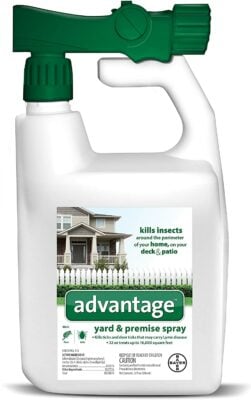
Editor’s Rating:
Why we like it: Bayer Advantage’s flea and tick spray is one of the few synthetics designed for fleas and ticks, and its expanded coverage area means it’s an excellent option for those with big yards.
At a Glance:
- Application Type: Hose
- Duration: 6 weeks
- Coverage Area: 16,000 square feet
- Price: $$
Ease of Use
Bayer Advantage’s hose applicator-bottle is effective on spaces up to 16,000 square feet, the widest coverage area of the products on this list. That makes it perfect for people with big yards.
Value & Effectiveness
It’s in the middle of the road on price, though depending on your yard size, the expanded coverage area may provide a better bang for the buck. However, duration is relatively low, which could mitigate some of the benefit of added coverage, depending on your situation.
It’s formulated for fleas and ticks and is safe to spray on decks and patios, though if your yard is filled with pollinators, an alternate product may be better.
Good to Know
Advantage’s flea and tick spray is a synthetic insecticide that uses a pyrethroid ingredient, and like all others in its class, it can be harmful to mammals, including people and pets, if it’s ingested in large amounts. It’s also toxic to bees and many species of fish.
Pros
- Large coverage area
- Simple application method
- Formulated to kill fleas and ticks
- Safe for use on plants
Cons
- Toxic to bees
- Low duration of effectiveness
8. Best Flea Killer for Small Yards: Natural Chemistry Yard & Kennel Spray
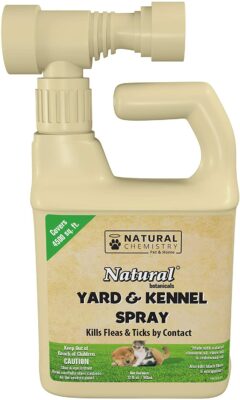
Editor’s Rating:
Why we like it: Natural Chemistry’s yard and kennel spray is formulated for fleas and ticks and comes without the health concerns of synthetic sprays. It’s also as effective as other natural sprays while being cheaper than its counterparts.
At a Glance:
- Application Type: Hose
- Duration: 8 weeks
- Coverage Area: 4,500 square feet
- Price: $$
Ease of Use
Natural Chemistry’s yard and kennel spray uses the familiar hose attachment, though the specific design is slightly different from most others, so it’s a good idea to test it out in a small area before you use it. That may mean you need to apply the product more often because there likely will be some waste because of the applicator.
Value & Effectiveness
Like all other products on this list that use natural ingredients, it’s less effective than those with heavy insecticides. That said, it does kill fleas and ticks on contact, as well as preventing infestations of flies and mosquitoes. But with a price that’s below average for natural sprays, the value is excellent, though the coverage area is also below average.
Good to Know
One of the main ingredients is cedarwood oil, and those with dogs who are prone to chewing on things in the yard or rolling around the in the grass will need to take extra precautions to ensure the product has had time to dry. The pleasant smell may be welcome for those accustomed to harsh scents of synthetic sprays.
Pros
- Simple applicator
- Effective against fleas, ticks, mosquitoes, and flies
- Below average price for natural product
- Smells good
Cons
- Requires multiple applications
- Contains cedarwood oil
9. Most Eco-Friendly Yard Flea Killer: Eco Defense Flea & Tick Control
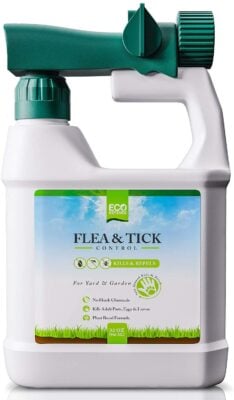
Editor’s Rating:
Why we like it: Eco Defense offers natural ingredients designed to create a barrier against fleas and ticks, and it may also help protect against mosquitoes, all without the negative effects of harsh ingredients.
At a Glance:
- Application Type: Hose
- Duration: 6 weeks
- Coverage Area: 5,000 square feet
- Price: $$
Ease of Use
The hose applicator attachment is simple, but its design can make it difficult to keep attached. This inconsistency is a drawback but being sure to test the attachment in a small area before use will help reduce waste.
Value & Effectiveness
Eco Defense’s price is above average for a natural product, but the eugenol-based formulation won’t cause the collateral damage that can happen with products using synthetic ingredients or potential damage from cedarwood oil.
The spray is effective, though it only lasts about six weeks, which means you may need to apply it often to maintain protection.
Good to Know
This spray is designed for fleas and ticks. That means it may be less effective against mosquitoes, and it won’t do much to repel flies. If you’re looking for a natural all-in-one product, consider Natural Chemistry’s yard and kennel spray.
There isn’t a strong odor, so those that find harsh chemical smells upsetting may enjoy this product.
Pros
- Easy application method
- Effective for fleas and ticks
- Not harmful to bees
- No bad smell
Cons
- Short duration
- Above average price for natural spray
10. Best Yard Flea Killer for Gardeners: Adams Yard Spray
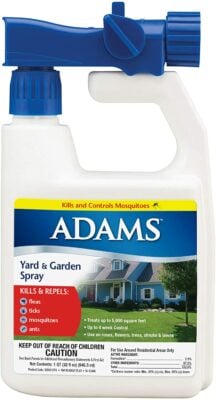
Editor’s Rating:
Why we like it: Fleas don’t live on people, but we’re sometimes used as a vehicle, so for those with their hands constantly in the garden, an outdoor flea spray could help them keep tinkering outside. While it’s a synthetic-based product, careful application can limit negative side effects.
At a Glance:
- Application Type: Hose
- Duration: 4 weeks
- Coverage Area: 5,000 square feet
- Price: $$
Ease of Use
The spray applicator is solid and simple to use, with one bottle covering up to 5,000 square feet.
Value & Effectiveness
Adams’ yard and garden spray is effective against fleas, ticks, mosquitoes, and ants, and it’s safe to use on plants. However, with a short duration, it does need to be applied regularly, which is not a problem for gardeners who are constantly outside tinkering in their lawns. Plus, it’s inexpensive, so it provides a good bang for the buck.
Good to Know
The main ingredient is permethrin, a pyrethroid that’s used on flea collars and in spot flea treatments, as well as in some products that treat lice in humans. High concentrations are potentially dangerous for cats, and it’s highly toxic to fish and bees. That’s why it’s best used by experienced gardeners who can be cautious and meticulous with using it responsibly.
Also, if your garden includes any food plants, be sure to wash them thoroughly before eating them (or feeding them to your family).
Pros
- Safe for use on plants
- Effective against fleas, ticks, and others
- Main ingredient also used in flea spot treatments for dogs
- Good coverage area
Cons
- Harmful to bees, and potentially harmful to cats
- Short duration
11. Longest-Lasting Yard Flea Killer: Control Solutions Pivot 10
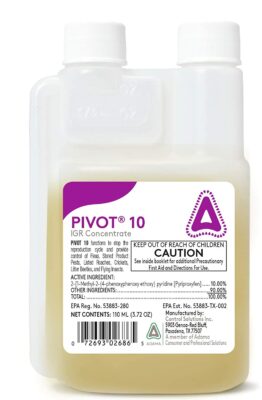
Editor’s Rating:
Why we like it: It’s a bit of a hassle, but pound for pound, no treatment on this list will last longer than Control Solutions’ Pivot 10 concentrate.
At a Glance:
- Application Type: Concentrate
- Duration: 28 weeks
- Coverage Area: 13,000 square feet
- Price: $$$
Ease of Use
Control Solutions’ Pivot 10 insecticide is by far the most complicated product on this list. It’s a concentrate, which means it must be mixed with water and loaded into a garden sprayer or other sprayer device.
Instructions are provided to ensure the water-to-concentrate mixture is accurate, but this could also lead to some trial and error, as it’s not always obvious which mix will be most effective in your yard.
Value & Effectiveness
Pivot 10 is the most expensive product on the list, natural or synthetic, but it’s also extremely effective, which makes it a good value. Plus, because you mix it yourself and the duration is long (about 28 weeks typically), a little will likely go a long way.
Like Black Flag’s spray treatment, Pivot 10 uses insect growth regulator pyriproxyfen, which works to kill off generations of fleas, ticks, roaches, crickets, mosquitoes, flies, and more.
Good to Know
This particular product is not currently sold in Alaska, and like others with Nylar, it can be toxic to certain fish species but shouldn’t interfere with adult bees, birds, or mammals.
Pros
- Very long duration
- Highly effective
- Huge coverage area
- Kills many types of insects
Cons
- Expensive
- Complex application method
Complete Guide to Yard Flea Killers

Every flea killer for use outside is a bit different, and understanding those differences is crucial to making a smart decision about which products you prefer.
Active Ingredients
Flea killers can be sorted into two broad camps based on what’s in them: synthetic and natural. Synthetic flea killers are made with one or more man-made insecticides, while natural flea killers use naturally occurring substances to control fleas.
The majority of synthetic flea killers on our list are in the pyrethroid family, a branch of chemicals that mimic natural pyrethrins, which are produced by Chrysanthemum and related flowers. When used on insects, they disrupt the nervous system, eventually causing death.
The most often-used natural ingredients are cedarwood oil and peppermint oil, and while they are used to kill and/or repel insects, if humans and other animals ingest large amounts of these some of these oils, they could be sickened.
Synthetic
Here, we’ll take a deeper look at the most common synthetic ingredients.
A pyrethroid that can be harmful to mammals, including humans, if ingested, and is harmful to bees. It’s included in BioAdvanced Complete granule flea killer.
This is a pyrethroid that’s classified by the U.S. Environmental Protection Agency as a possible human carcinogen, which means some evidence suggests it may cause cancer in people, but more study is needed to make a definitive determination. Toxicity in birds is low, but it’s extremely toxic to bees. It’s included in Ortho Home Defense spray.
A pyrethroid that can be harmful to mammals, including humans, if ingested in large amounts. It’s somewhat toxic to birds and highly toxic to bees and many fish. It’s included in Bayer Advantage yard spray.
A systemic insecticide that’s part of class called neonicotinoids because they mimic nicotine. Mammals, including humans, can be sickened if they ingest large amounts, and imidacloprid, as well as other neonicotinoids, are extremely toxic to honeybees. This is included in BioAdvanced Complete.
A pyrethroid that’s highly toxic to fish and bees, though toxicity in bees is lower when the substance isn’t ingested. It can be harmful to mammals when ingested. You can find it included in Cutter spray and Black Flag spray.
A pyrethroid that’s commonly used in flea collars and spot treatments used on dogs, and it’s in some human products to treat lice. High concentrations can be dangerous for cats, and it’s highly toxic to fish and bees. It’s included in Ortho Home Defense spray and Adams yard spray.
An insect growth regulator, also known by the brand name Nylar, that disturbs the reproductive cycle of insects. Birds, mammals, and adult honeybees are not susceptible to pyriproxyfen, but it can be toxic for fish depending on the species. It’s included in Black Flag spray and Control Solutions Pivot 10.
Pyrethroid that’s highly toxic to fish and bees, and based on animal studies, the EPA has classified it as possibly carcinogenic to people, though further study would be needed. Included in Ortho Home Defense spray.
Natural
Some flea killers use natural ingredients to get the job. We’ll explore some of the most common ones here.
Cedarwood Oil
This is made from the foliage and wood of pine and cypress trees. It can be dangerous if consumed in large quantities by dogs. It’s included in Wondercide spray and Natural Chemistry spray.
Eugenol
An oil extracted from cloves, cinnamon, and other spices. It’s included in Vet’s Best, Natural Chemistry, and Eco Defense sprays.
Peppermint Oil
This oil is made from the flowers and leaves of the peppermint plant. It’s included in Vet’s Best spray.
Sesame Oil
This is made from non-roasted sesame seeds (not the same as the cooking oil). It’s included in Wondercide spray.
Sodium Lauryl Sulfate
Many flea killers that rely on natural ingredients also use a chemical compound, sodium lauryl sulfate (SLS), to enhance the effectiveness of the product, ensuring it’s thoroughly applied. SLS is found in many personal care products, particularly toothpaste and shampoo. Direct skin contact with large amounts of SLS can cause skin irritation, though the compound is not harmful to most people.
Legal Restrictions
To complicate matters even further, the choice between natural and synthetic ingredients could have legal implications. While none of the ingredients on this list have been banned outright in the U.S., one of them — imidacloprid — is controversial because of its believed impact on honeybees.
Imidacloprid belongs to a class of pesticides called neonicotinoids, and a growing body of evidence suggests that these chemicals have a negative effect on honeybees and other important pollinators. Four states so far have enacted legislation to limit use of these types of pesticides, and legislation is pending in several states. Because of that, BioAdvanced Complete flea killer can’t be sold in several New York counties and its use may be restricted in Connecticut, Maryland, and Vermont.
In cases where laws don’t restrict use, certain products are not registered for sale in some states. For example, Pivot 10, which uses an insect growth regulator, hasn’t been approved for sale in Alaska.
It’s possible that as scientific understanding of potential negative effects of ingredients in synthetic flea killers continues to evolve, states, cities, and counties could adopt restrictions or bans on certain chemicals. So, in the case of flea killers for the yard, it may be best to keep your mind open to multiple products.
Coverage Area
Each of these products is designed to be sprayed or spread across thousands of square feet, with most products listing a coverage area of 5,000 square feet. While this is a good guideline to follow, the number of pets you have and the extent of any current flea infestation may render that coverage area irrelevant if you need to saturate the ground more often.
Also, understanding exactly where fleas come from can help you be sure that unwanted visitors aren’t to blame for your flea infestations. After all, the fleas in your yard probably aren’t coming from your cat or your dog. Learn more about fleas (way more than you’d ever want to know, if we’re honest) in this article.
In addition to the size of your yard helping to determine what product is ideal, you also should take into account any trees, plants, flowers, or anything else that you want to keep growing in your yard. Some products are relatively safe for plant life, though none are really designed to be plant-safe.
Duration
How long your yard is protected also varies by product, though it’s important to note that the duration listed by the manufacturers applies only to ideal application circumstances. What that means is that if you apply a flea killer and shortly before it’s completely dry, a rainstorm comes through, it’s likely your protection won’t last as long as the manufacturer suggests.
On the other hand, if you have a very small yard and use a product designed for a large yard, your protection may last even longer, though you’ll likely need to wait longer for that application to dry fully.
The listed duration of protection on the products that made our list ranges from four weeks to 28 weeks.
Application
For flea killers designed for outdoor use in your yard, the most common application method is a spray attachment that you connect to a garden hose. All but two products that made our list have that application method.
Here’s a look at the three types of possible application method for flea killers designed for yards:
- Hose
- Granules
- Concentrate
In all cases, the product mixes with water and is left to soak into the ground and dry on top of the lawn, or whatever ground covering exists.
Hose
Hose-based applicators are by far the easiest, though some of them can be tricky if it’s your first time using such a product. Many weedkillers, cleaners, and other outdoor products use this method, so you may already be familiar with hose applicators.
Granule
Granule-based products require the use of a seed spreader to ensure an even distribution, though if you’re willing to take the time, this also can be done manually (if you’re wearing gloves). Once you’ve spread the granules, you saturate them using a garden hose (or sprayer if you don’t have a hose nearby), then wait for the mixture to dry.
Concentrate
Similarly, concentrate products require the use of a container to mix water with the flea killer. A garden pump sprayer can be helpful for this, and they can be used for many functions outside the house.
In every case, even for natural-based products, be sure to cover exposed skin and wear eye protection. Additionally, each product has its own set of instructions, so it’s important to understand and follow these, as the effectiveness of a flea killer can be diminished if the instructions aren’t followed.
Alternatives
Many of the products that are most effective at killing fleas also are, unfortunately, harmful for other forms of wildlife — especially bees. While it’s still possible to use these products safely, depending on what exactly is in your yard and what time of year you’re applying the flea killer, some folks may prefer to take a gentler approach.
Here’s a look at some DIY recipes for flea killer/flea repellants:
Dish Soap
Fill a plate or bowl with warm water and dish soap and set it outside at night. Depending on the size of your yard, you may need several containers and should repeat the process several nights in a row.
Nematodes
Introduce nematodes to your yard. These tiny worms, which feed on eggs and larvae of fleas and other pests, are safe for people and pets. These can be purchased online or at your local garden center.
Lemon Juice and Vinegar
Create a mixture of lemon juice, water, and vinegar and apply it all over the yard, especially in areas with tall grass, bushes, trees, or shrubs.
Also, try to keep the grass cut short during the mowing season, and avoid having shrubs near doors and windows.
Signs of Flea Infestation
Because of their tiny size, you can’t see fleas in your yard, but you certainly can see signs of them on your pets — and even yourself. Some of the telltale signs of fleas include:
Your Pet Keeps Scratching Themselves
Constant itching and scratching by pets, particularly new instances of scratching or restlessness, can be a sign of a flea infestation. In some cases, household pets may scratch areas to the point of creating a sore on their body that could become infected.
You See Dark Specks on Your Scratching Pet
If your pet is scratching constantly, use a comb to separate some of their fur. If you see a dark speck, typically brown, black, or reddish, that moves, that’s most likely a flea. Dark specks on your pet that don’t move may be flea dirt (which is feces).
There Are Flea Bites on Your Pet
Flea bites also are visible to the eye, and these usually can be found on the belly, rear, neck, and ears of most house pets like dogs, cats — and even rabbits.
There Are Flea Bites on You
You may experience a flea bite, but fleas don’t live on humans. You may notice itchy red bumps on your feet or ankles, which may be flea bites.
If you see fleas on your pet or flea bites on your pet or yourself, it’s important to thoroughly wash any fabric or other soft surface. Bedding, possibly including yours, must be washed in hot water, and if your pet comes into contact with furniture, that must be thoroughly cleaned as well by vacuuming its cushions and cracks.
Also, in addition to any home remedies or flea killer products, like flea shampoos, most vets recommend cats and dogs receive a flea preventive, which can be in the form of a medication or a topical treatment. A flea infestation can spread quickly, so you should use as many tools as possible to prevent it. We recommend taking your pet to their vet to make sure they receive the proper, safe treatment.
Yard Flea Killer FAQs

Here’s a look at some of the questions readers most frequently ask about flea killers for the yard.
Are Yard Flea Sprays Safe for Pets?
Yes, though it’s important to follow all included instructions. All flea sprays designed for yards have a specific length of time they need to dry onto the ground, and if you allow your pet access to the yard before this time is up, it’s possible they could ingest or otherwise contact the spray, which could make them ill.
A pet should never ingest any type of flea killer for the yard, regardless of its ingredients.
How Long Does a Yard Flea Killer Last?
The effective duration of yard flea killers ranges from a few weeks to a few months, though this can depend on many factors that are out of your control. This includes weather, seasons, and even wind — these all can cause flea killer products to be less effective. But typical yard flea killers last at least a couple of months.
Are Fleas Dangerous for Pets and Humans?
Fleas do far more than cause itching on humans and animals. In addition to secondary infections caused when a scratch-related wound becomes infected, fleas can be hosts for tapeworm larvae, and pets or people who ingest a flea or parts of a flea can develop a tapeworm infection. Left untreated, a tapeworm can cause a person or pet to develop anemia, which can be life-threatening in some situations. Because they are bloodsuckers, fleas are especially dangerous for young and/or very small animals, including kittens and puppies.
How Long Do Fleas Live?
If it’s feasting on a suitable host, an adult flea can live up to one year, though that requires ideal circumstances. They typically live between 60 and 100 days, and female fleas only produce eggs if they are living on a host, but a female can produce 50 eggs per day.
What Animals Carry Fleas?
Housepets like cats and dogs are the ideal host for fleas, but they also can attack other family pets, including ferrets, guinea pigs, and rabbits. Wild animals also are susceptible to fleas, and they can spread fleas into your yard; this includes raccoons, opossums, skunks, foxes, and deer.
Final Thoughts
Pests like fleas and ticks are an unfortunate reality of life on earth. Because you can’t encase your yard in a bubble, the chances of never again seeing a flea or the signs of a flea infestation in your yard are low.
The good news is that there are many products designed to help reduce flea and tick populations that, when used in conjunction with prescribed flea preventives, can keep these pesky pests at bay.
